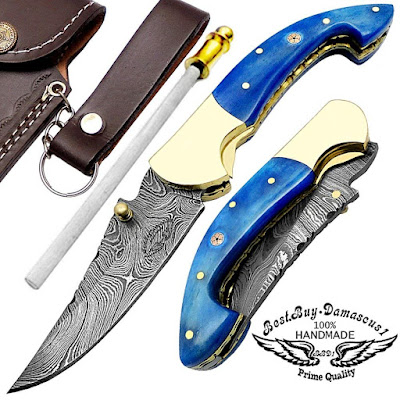Damask Handmade damascus hunting knives Defined
The Handmade damascus hunting knives is named after its
owner who made the Handmade
damascus hunting knives famous: Jim Bowie. Most think of a Bowie as
a knife with a long blade. There are variations of Bowies with a blade of 4.
"These were a favorite knife of the riverboat player. This knife is often
known as Bowie" Vest Pocket. "Bowie blades can reach up to 14";
however, the ideal point for the length of the Bowie blade is 9 "-
11". Jim Bowie's knife had a 9.25 "blade.
The Damask Bowie is reintroduced.
Many objects of legends and traditions will vanish after 189
years, but not the Handmade damascus hunting knives. Thanks in large part to
the American Blade Smith Society (ABS) and to the men and women who make up
this organization. The forged knife has remained alive all over the world. Bill
Moran, the patriarch of ABS, is credited with the rediscovery of the creation
of Damascus.
Damascus is basically the combination of two or more steels.
In the case of most of the Damascus sheets forged today, these steels are made
of basic carbon steel, such as 1084 which is combined with 15N20. Nickel in
15N20 steel resists acid etching and stays bright. It is the combination of
engraving and brightness that gives Damascus its distinctive look.
Most forged blades are flat ground. In short, this means
that the blade narrows from the spine to the edge from both sides. Doing so makes
this task more difficult since the manufacturer has to remove a large amount of
metal. The advantage obtained is a lighter blade that maintains its integrity.
Another technique used with forged blades is differential
heat treatment. Basically, this creates a harder edge and a softer spine. The
blade will usually have a quench line that shows the difference between the
harder and softer parts of the blade.
The carbon steels used are too numerous to mention here. The
main ones used with forged Bowie blades are; 0-1, W-2, 1075, 1084, 1095, 5160
and 52100.
There are three basic types of mangoes. First, the hidden
flavor; which is exactly what it seems. A hole is drilled and formed through
the center of the handle material to make room for the spike. Epoxy is often
used as an adhesive to hold the tang together and handle the material.
Depending on the material and the manufacturer, the handle
may or may not have a pin through the handle. This type of knife handle will
also lend itself to the disassembly handle. The handle is constructed in a
similar way, but with a greater degree of adjustment, since no glue is used to
secure the spike and handle the material. The handle is held together with a
type of nut or cap that is screwed into the tongue and provides the necessary
pressure to keep the handle secure. In general, a tool is provided to remove
the device that holds the knife.
In second place is the tang shroud. The spike will be
shorter and the handle material will be spit out. The interior of the handle material
will have a uniform groove cut on both sides. This will allow the spike to be
sandwiched between both pieces of handle material. This technique will almost
always have a combination of epoxy and some type of pin through the handle. An
advantage of this type of handle is the reduction of weight. This can really
help with a hunter / skinner, as well as helping in the balance of the knife.
The third is the handle of the frame. Basically, the spike
is slotted into a frame and the handle material is added to each side. When
finished, it gives the illusion that the knife has a full tang. In general,
built with both hidden and showing pins. This is the most complex method of the
three. Expect to pay more for this type of mango.
While all of Damascus is forged, the way it becomes a knife
may be different. Manufacturers who forge their knives will usually make their
own Damascus. While many manufacturers who use the disposal method will buy
their Damascus from a third party that specializes in manufacturing Damascus.
Bowies created by the stock removal method differ mainly
from counterfeit Bowies in two main ways:
1) Steel: Basically, stainless steel is used instead of
carbon steel.
2) Handle: generally, a full-Tenon construction or concealed
spike.



Comments
Post a Comment